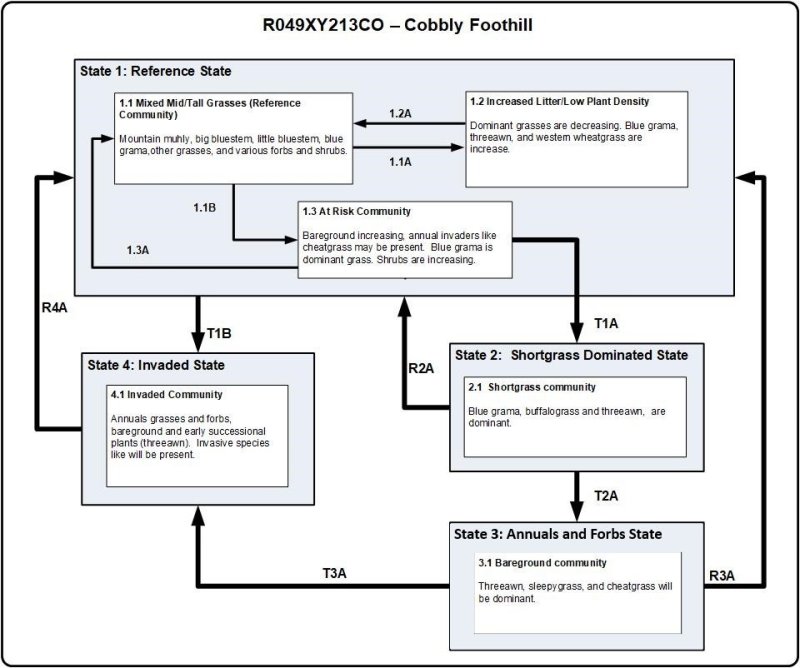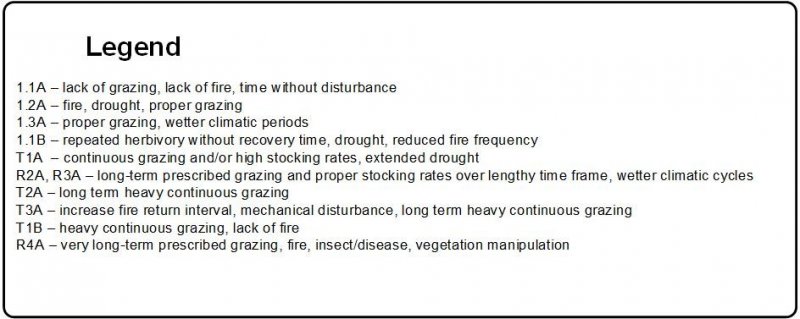
Natural Resources
Conservation Service
Ecological site R049XY213CO
Cobbly Foothill
Last updated: 9/07/2023
Accessed: 04/02/2025
General information
Provisional. A provisional ecological site description has undergone quality control and quality assurance review. It contains a working state and transition model and enough information to identify the ecological site.
MLRA notes
Major Land Resource Area (MLRA): 049X–Southern Rocky Mountain Foothills
MLRA 49 is in Colorado (58 percent), Wyoming (27 percent), and New Mexico (15 percent). It makes up about 11,130 square miles (28,845 square kilometers). The major cities in or adjacent to this MLRA are Laramie, Wyoming; Fort Collins, Boulder, Denver, Colorado Springs, and Pueblo, Colorado; and Santa Fe and Las Vegas, New Mexico. Interstates 25, 70, and 80 cross the MLRA. Part of the Medicine Bow National Forest is in the northern tip of this area, in Wyoming; parts of the Roosevelt, Pike, and San Isabel National Forests are in this area in Colorado; and part of the Santa Fe National Forest is in the southern end of this area, in New Mexico. The Rocky Flats Nuclear Arsenal, Peterson Air Force Base, most of the Air Force Academy grounds, and part of the Fort Carson Military Reservation are in the part of this area in Colorado.
Almost half of this area is in the Southern Rocky Mountains and Wyoming Basin Provinces in the Rocky Mountain System. The rest is in the Colorado Pediment, Raton, and High Plains Sections of the Great Plains Province of the Interior Plains. The northern part of the MLRA consists of the Laramie Mountains. The central and southern parts generally are bounded on the east by the Great Plains and on the west by the Southern Rocky Mountains. Elevation ranges from 5,000 feet (1,525 meters) to 8,000 feet (2,440 meters) in most of the MLRA, but small mountains in the area are as high as 10,000 feet (3,050 meters). The Laramie and North Platte Rivers and their associated tributaries are the principal streams in the Wyoming portion of the MLRA. The Cache La Poudre, Big Thompson, Saint Vrain, South Platte, Arkansas, Saint Charles, Huerfano, Cucharas, and Purgatoire Rivers, Clear Creek, Fountain Creek, and their associated tributaries are the principal streams in the Colorado portion. The Vermejo, Cimarron, Pecos, and Mora Rivers and their associated tributaries are the principal streams in the New Mexico portion.
This area has been impacted by the geologic processes of uplift, folding, and faulting and by subsequent erosion and deposition. The Southern Rocky Mountains were uplifted 50 to 70 million years ago during the Laramide uplift. Most of this MLRA is adjacent to this uplift and was also affected. The uplift induced erosion of the relatively soft Late Pennsylvanian to Cretaceous sedimentary rocks from the uplands and dissected the underlying crystalline Precambrian rocks. The relief of the area was reduced by a combination of erosion of uplands and alluvial filling. Approximately 7 million years ago, a large portion of the area was uplifted again to elevations of 14,000 feet (4,270 meters) or more at the core of the Laramide uplift. Since then, precipitation occurring as both rain and snow led to the renewal of erosion and subsequent alluvial fills. The Wyoming portion of the MLRA, the Laramie Mountains, consists primarily of Precambrian plutonic rocks with Pennsylvanian and Permian sedimentary rocks folded and faulted at the margin of the range. The Colorado and New Mexico portions of the area consist primarily of remnants of the uplifted and folded Pennsylvanian through Cretaceous sedimentary rocks forming hogbacks, ridges, and hills, the ranges of which trend in a general north-south direction, parallel to the uplifted Southern Rocky Mountains. Tertiary volcanic flows filled valleys in some areas. After extensive erosion, these more resistant volcanic rocks now form prominent mesas, such as North and South Table Mountains near Golden, Colorado, and Fishers Peak Mesa near the Colorado-New Mexico border. Stream erosion from the eastern front of the Southern Rocky Mountains fostered the creation of a sequence of large alluvial fan remnants, pediments, and terrace deposits in this MLRA.
The average annual precipitation is 12 to 25 inches (305 to 635 millimeters) in most of this area, but it ranges from 10 to 35 inches (255 to 890 millimeters), generally increasing with elevation. The highest precipitation occurs in the Laramie Mountains, in Wyoming, and the lowest precipitation occurs in the Arkansas River Valley, above Salida, Colorado. Most of the rainfall occurs as high-intensity, convective thunderstorms during the growing season. Winter precipitation occurs as snow. The average annual temperature is 36 to 54 degrees F (2 to 12 degrees C). The freeze-free period averages 140 days and ranges from 90 to 195 days, decreasing in length with elevation and from south to north.
The dominant soil orders in this MLRA are Mollisols, Alfisols, Inceptisols, and Entisols. The soils in the Colorado and New Mexico portions of the MLRA dominantly have a frigid or mesic soil temperature regime. Those in the Wyoming portion have a frigid or cryic soil temperature regime. A few of the higher peaks and some north aspects have a cryic soil temperature regime. Most of the soils in the area have an ustic soil moisture regime, but those on the higher peaks and on some north aspects have a udic soil moisture regime. The soils in the area dominantly have smectitic or mixed mineralogy. They are very shallow to very deep and are dominantly well drained. The texture is dominantly loamy in soils that formed in material weathered from igneous and metamorphic rocks and is dominantly loamy or clayey in soils that formed in material weathered from sedimentary rocks. Some of the most extensive and representative great groups are Haplustolls (Baller series), Argiustolls (Nederland, Nunn, Santa Fe, and Enmedio series), Haplustalfs (Fort Collins, Stoneham, and Dargol series), Haplustepts (Stout series), Ustorthents (Lorencito and Saruche series), and Paleustolls (Flatirons series). (USDA-NRCS, 2006)
Classification relationships
NRCS:
Major Land Resource Area 49, Southern Rocky Mountain Foothills (United States Department of Agriculture, Natural Resources Conservation Service, 2006).
USFS:
M331Ib – North Front Range; M331Ic – North Laramie Mountains; M331Id – South Laramie Mountains; and M331Ii – Northern Arkansas Granitics – 39 mile Mountain M331I – Northern Parks and Ranges M331 - Southern Rocky Mountain Steppe - Open Woodland - Coniferous Forest - Alpine Meadow
M331Fb – Wet Mountains; M331Fc – Wet Mountain Valley; M331Ff – Raton Basin; M331Fg – Sangre de Cristo Mountains Woodland; and M331Fh – Sangre de Cristo Mountains Coniferous Forest M331F – Southern Parks and Rocky Mountain Range M331 - Southern Rocky Mountain Steppe - Open Woodland - Coniferous Forest - Alpine Meadow
331If – Arkansas Valley Tablelands; 331Ig- Arkansas Valley High Tablelands; 331Ih – Black Forest; and 331Ii – Southern Front Range Foothills < 331l – Arkansas Tablelands < 331 Great Plains – Palouse Dry Steppe
331Ha – Southern Denver-Julesburg Basin; 331Hc – Eastern Central High Plains; 331He – Northern Front Range Foothills and 331Hf – Denver-Julesburg Basin < 331H – Central High Plains < 331 Great Plains – Palouse Dry Steppe
EPA:
21b – Crystalline Subalpine Forests, 21c – Crystalline Mid-Elevations Forests, 21d -Foothill Shrublands, 21e – Sedimentary Subalpine Forests, and 21f – Sedimentary Mid-Elevation Forests, 21j – Grassland Parks < 21 Southern Rockies < 6.2 Western Cordillera < 6 Northwestern Forested Mountains North American Deserts (Griffith, 2006).
25c – Moderate Relief Plains, 25d – Flat to Rolling Plains, and 25l – Front Range Fans < 25 High Plains < 9.4 South Central Semi-Arid Prairies < 9 Great Plains (Griffith, 2006).
26e – Piedmont Plains and Tablelands, 26f- Mesa de Maya/Black Mesa, 26h- Pinyon-Juniper Woodlands and Savannas, 26i – Pine-Oak Woodlands, 26j – Foothills Grasslands, 26k – Sandsheets, and 26l – Upper Canadian Plateau < 26 Southwestern Tablelands < 9.4 South Central Semi-arid Prairies < 9 Great Plains (Griffith, 2006).
USGS:
Southern Rocky Mountain Province, Colorado Piedmont and Raton
Ecological site concept
R049XY213CO Cobbly Foothill occurs on fans, terraces, stream terraces, fan terraces, mesas and cuestas. Slopes is between 5 to 25 percent. Soils are moderately deep to very deep with depths of greater than 20 inches. Soils are derived from alluvium, colluvium and/or residuum primarily from sandstone and//or sedimentary rock. Soil surface texture is extremely cobbly sandy loam, stony sandy loam, cobbly sandy loam or extremely cobbly loam. Family particle size is loamy-skeletal or clayey skeletal. It is a Mountain Muhly – Big Bluestem community. It has a typic ustic moisture regime. The effective precipitation ranges from 15 to 18 inches.
Associated sites
| R049XD202CO |
Loamy Foothill 11-14 PZ This site occurs on fans, fan remnants, hills, hillslopes, and valley sides. Slopes is between 0 to 20%. Soils are moderately deep to very deep with depths of greater than 20 inches. Soils are derived from alluvium and residuum from sedimentary rocks (sandstone, siltstone and shale). Soil surface texture is loam, silt loam or very fine sandy loam. Family particle size is loamy. It is a Winterfat – Four-wing saltbush – Western wheatgrass – Blue grama plant community. It has a typic ustic moisture regime. The effective precipitation ranges from 14 to 19 inches. |
|---|---|
| EX049X01X202 |
Loamy Foothill Palmer Divide This site occurs on fans, fan remnants and hills. Slopes is between 0 to 10%. Soils are moderately deep to deep in depths of greater than 20 inches. Soils are derived from alluvium from sandstone. Soil surface texture is fine sandy loam, loam clay loam or silty clay loam. Family particle size is loamy. It is a Winterfat – Western wheatgrass – Blue grama plant community. It has ustic aridic/aridic ustic moisture regime. The effective precipitation ranges from 11 to 14 inches. |
Similar sites
| R049XY214CO |
Gravelly Foothill This site occurs on gently rolling and sloping uplands. Slopes is between 0 to 35%. Soils are deep and greater than 60 inches in depth. Soils are derived from slopes alluvium, alluvium and colluvium from arkose or igneous and metamorphic rocks. Soil surface texture is gravelly, sandy loam, cobbly sandy loam, gravelly loam or very gravelly loam. Family particle size is sandy-skeletal, loamy-skeletal or fine-loamy over sandy-skeletal. It is a Little Bluestem – Needle-and-Thread community. It has an aridic ustic moisture regime. The effective precipitation ranges from 12 to 16 inches. |
|---|---|
| R049XB212CO |
Shaly Foothill This site occurs on break areas with short steep slopes that expose the raw shale parent material. Slopes is between 3 to 35%. Soils are shallow with depths of 6 to 20 inches. Soils are derived from slopes alluvium, and/or residuum primarily from shale or clayey shale. Soil surface texture is clay, clay loam, silt loam or gravelly clay loam. Family particle size is clayey or loamy. It is a Western Wheatgrass– Green Needlegrass community. It has an aridic ustic moisture regime. The effective precipitation ranges from 13 to 18 inches. |
Table 1. Dominant plant species
| Tree |
Not specified |
|---|---|
| Shrub |
Not specified |
| Herbaceous |
(1) Muhlenbergia montana |
Click on box and path labels to scroll to the respective text.

